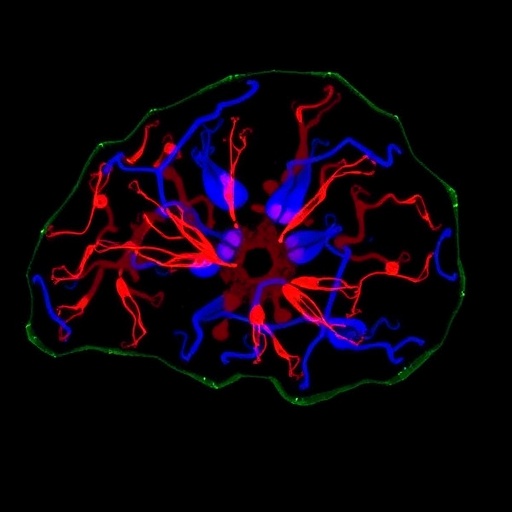In a groundbreaking study that redefines our understanding of brain development, researchers have uncovered the intricate mechanisms that govern the specification of astrocytes within the mouse septum. This new research reveals that astrocyte identity is not solely predetermined by their developmental origin but is critically modulated by local environmental signals. This discovery has far-reaching implications for neuroscience, particularly in how glial cells contribute to brain architecture and function.
Astrocytes, the star-shaped glial cells abundant in the central nervous system, play indispensable roles beyond their traditional supportive functions. They regulate neurotransmitter levels, maintain the blood-brain barrier, modulate synaptic activity, and influence neural plasticity. Despite their critical involvement in brain physiology, the developmental pathways that specify astrocyte subtypes have remained ambiguous, especially in complex brain regions like the septum—a major limbic structure involved in emotional and cognitive processes.
The septum, positioned along the midline of the brain, serves as a crucial hub connecting various limbic areas. Given its involvement in mood regulation, learning, and memory, any alterations in its cellular composition can have profound behavioral consequences. Understanding how astrocytes in this region acquire their unique identities could unveil new dimensions in neurodevelopmental biology and potentially inspire therapeutic strategies for neurological disorders linked to septal dysfunction.
.adsslot_Yc8RELWMo6{ width:728px !important; height:90px !important; }
@media (max-width:1199px) { .adsslot_Yc8RELWMo6{ width:468px !important; height:60px !important; } }
@media (max-width:767px) { .adsslot_Yc8RELWMo6{ width:320px !important; height:50px !important; } }
ADVERTISEMENT
Using sophisticated genetic tracing techniques combined with high-resolution imaging, the research team meticulously mapped the developmental lineage of astrocytes emanating from distinct progenitor zones. Their findings highlight that astrocytes within the septum do not stem from a homogeneous progenitor pool; rather, they arise from multiple discrete origins. Notably, astrocytes originating from different progenitor regions exhibit diverse molecular signatures and functional properties, underscoring the heterogeneity inherent in astroglial populations.
However, developmental origin alone fails to fully explain the observed astrocyte identities. The authors demonstrate that astrocytes undergo further specification influenced by dynamic local signals present in their microenvironment. These signals include morphogens, extracellular matrix components, and intercellular communication cues that collectively modulate gene expression patterns, ultimately fine-tuning astrocyte specialization.
One of the pivotal aspects of this study is the identification of local signaling pathways that interface with lineage-specific transcriptional programs. The intricate crosstalk between extrinsic cues and intrinsic genetic determinants orchestrates the emergence of astrocyte subtypes with distinct phenotypic traits. This nuanced interplay ensures that astrocytes are optimally adapted to meet the functional demands of their specific septal niches.
The research sheds light on molecular mediators such as Sonic Hedgehog (Shh) and Bone Morphogenetic Proteins (BMPs), which have been previously implicated in neurodevelopmental processes. Their spatial and temporal gradients within the septum appear to act as positional information signals, guiding astrocyte fate decisions in a context-dependent manner. Such insights pave the way toward deciphering the code by which astrocytes integrate developmental provenance with environmental cues.
In addition to signaling molecules, the study explores the role of epigenetic modifications in stabilizing astrocyte identities. Epigenetic landscapes within astrocytes exhibit plasticity during early development but become progressively locked as cells mature. Local signals contribute to remodeling chromatin accessibility, thereby reinforcing cell-specific gene regulatory networks. This epigenetic regulation ensures long-lasting maintenance of astrocyte phenotypes amidst changing physiological conditions.
The methodology implemented in this work is remarkable in its precision and scope. Employing single-cell RNA sequencing, the authors cataloged transcriptional profiles at multiple developmental stages. This approach captured the dynamic transitions as progenitors give rise to their astrocytic progeny, revealing key genetic markers indicative of lineage trajectories and environmental modulation.
Functional assays complement the transcriptomic data, demonstrating that astrocytes specified under distinct local signaling regimes exhibit differential capacities for synaptic modulation and neurovascular interactions. Such functional diversity among astrocyte subtypes within the septum likely underpins the region’s complex influence over learning, memory consolidation, and emotional regulation.
Beyond basic science, these findings hold potential translational value. Astrocyte dysfunction is increasingly recognized in a variety of neurological and psychiatric disorders, including epilepsy, depression, and Alzheimer’s disease. By delineating the developmental and environmental factors that shape astrocyte phenotypes, this research may inform strategies for targeted glial therapies that restore or modulate brain homeostasis.
An intriguing implication of this study is the concept that therapeutic interventions could be designed to manipulate local signaling environments. Modulating extrinsic cues could potentially recalibrate aberrant astrocyte identities or functions in disease contexts. This approach would complement existing neuron-focused treatments, broadening the scope of neurotherapeutics.
Moreover, the discovery of astrocyte heterogeneity rooted in both intrinsic lineage and extrinsic signals challenges the traditional binary classification of glia. It supports emerging paradigms viewing astrocytes as a mosaic of specialized subtypes finely attuned to their microenvironment. This complexity must be factored into future studies examining glial contributions to brain function and pathology.
This research also raises compelling questions about how environmental factors in postnatal life might further influence astrocyte identity. The septum, continuously exposed to internal and external stimuli, may harbor additional mechanisms adjusting astrocyte function beyond early development. Future investigations may unravel how experience and injury reshape glial phenotypes in this vital brain region.
In sum, the elucidation of astrocyte specification within the mouse septum as dependent upon both developmental origin and local instructive signals marks a significant advance in neurobiology. It enriches our conceptual framework of glial diversity and emphasizes the importance of niche-specific cues in brain cell fate determination. The detailed landscape painted by this study will undoubtedly inspire further explorations into the interplay between genetics and environment in shaping neural circuits.
As the field progresses, insights gleaned from such research not only deepen our fundamental understanding of brain development but also inspire innovative interventions targeting astrocytes. A fuller appreciation of these star-shaped cells, once deemed mere support elements, positions them at center stage in the orchestration of cognition and behavior. This study opens a vibrant frontier in neuroscience where developmental blueprint and local milieu coalesce to sculpt the essential architecture of the mind.
Subject of Research: Astrocyte development and specification in the mouse septum, focusing on the influence of developmental origin and local microenvironmental signals.
Article Title: Astrocyte specification in the mouse septum is shaped by both developmental origin and local signals.
Article References:
Xie, Y., Reid, C.M., Turrero Garcίa, M. et al. Astrocyte specification in the mouse septum is shaped by both developmental origin and local signals. Nat Neurosci (2025). https://doi.org/10.1038/s41593-025-02007-z
Image Credits: AI Generated
Tags: astrocyte development in mouse septumastrocyte identity and functionastrocytes and brain architectureblood-brain barrier maintenanceemotional and cognitive processes in the brainglial cells in central nervous systemimplications for neurological disordersmechanisms of astrocyte specificationneurodevelopmental biology of astrocytesrole of environmental signals in brain developmentseptum’s role in mood regulationsynaptic activity modulation by glial cells






